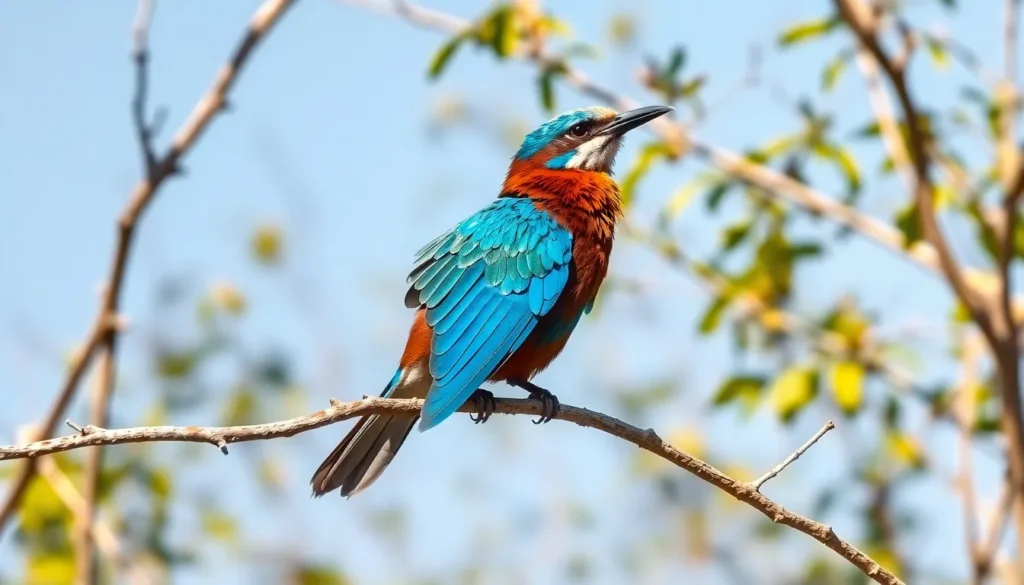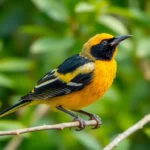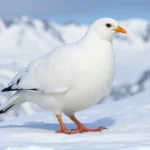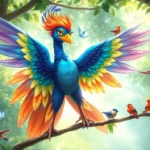We’ve all witnessed breathtaking aerial displays in nature but few birds can match the spectacular acrobatic performances of the Indian Roller. This vibrant blue-winged marvel transforms the sky into its personal stage with dramatic dives rolls and tumbling maneuvers that’ll leave you absolutely mesmerized.
Known scientifically as Coracias benghalensis the Indian Roller isn’t just another pretty bird – it’s a master of survival and showmanship. We’re talking about a species that’s earned its place as India’s state bird of three different states and captured the hearts of birdwatchers across Asia and beyond.
Whether you’re a seasoned birder or someone who’s just discovered the magic of avian life the Indian Roller offers something extraordinary. From its stunning plumage that shifts from earthy browns to brilliant azure blues to its fascinating hunting techniques and cultural significance we’re about to explore why this remarkable bird deserves a spot on every nature lover’s must-see list.
Physical Characteristics of the Indian Roller Bird
The Indian Roller displays remarkable physical features that make it instantly recognizable among South Asian bird species. We examine the distinctive traits that define this aerial acrobat’s appearance and structure.
Size and Body Structure
Indian Rollers measure 26-27 centimeters in length with a robust build typical of the roller family. We observe their stocky bodies featuring broad heads that house powerful beaks designed for catching insects and small prey. Their wings span approximately 65-74 centimeters when fully extended during flight. These birds possess sturdy legs measuring 3-4 centimeters that provide excellent perching stability on telegraph wires and tree branches. Adult Indian Rollers weigh between 166-176 grams on average. Their compact frame supports the intense aerial maneuvers that define their hunting and courtship behaviors.
Distinctive Plumage and Coloration
The Indian Roller’s plumage creates one of nature’s most striking color displays across the Asian subcontinent. We identify their rich brown backs and breasts that contrast dramatically with brilliant turquoise blue wing coverts. Their throat displays a purplish hue that transitions into the brown chest coloring. Flight reveals spectacular bright blue patches on the wings and tail that flash like jewels against the sky. The head features a brownish cap with subtle streaking patterns. Their underwing coverts show intense azure blue that becomes visible during their characteristic rolling flight displays. These vibrant colors intensify during breeding season when hormonal changes enhance the bird’s natural pigmentation.
Sexual Dimorphism
Male and female Indian Rollers exhibit minimal sexual dimorphism that makes field identification challenging for casual observers. We note that males typically display slightly brighter blue coloration on their wings and tail feathers during breeding season. Their overall size remains nearly identical between sexes with males averaging just 2-3 grams heavier than females. Both sexes possess the same distinctive color patterns and markings throughout the year. Males demonstrate more pronounced territorial behaviors and perform elaborate aerial displays that involve their signature rolling flight patterns. The subtle differences become most apparent during courtship rituals when males showcase their plumage through acrobatic performances.
Natural Habitat and Geographic Distribution
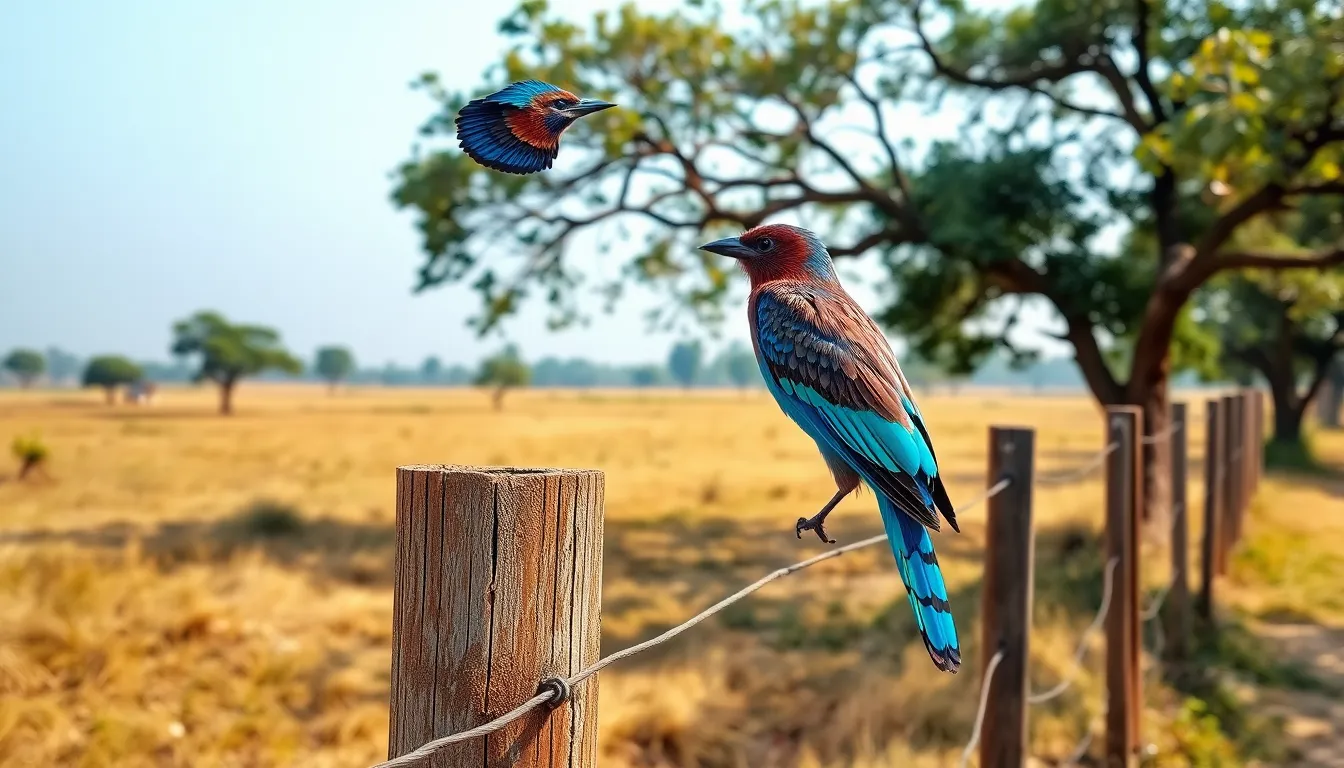
The Indian Roller thrives across diverse landscapes from the Middle East to Southeast Asia. We observe this adaptable species flourishing in environments that provide adequate perching sites and abundant insect prey.
Native Range Across Asia
India serves as the core habitat for Coracias benghalensis populations, extending from the Western Ghats to the northeastern states. Pakistan, Bangladesh, Myanmar, and southern China host important breeding populations throughout their open grasslands and cultivated regions. The species occupies territories across Afghanistan, Nepal, Bhutan, and extends into Thailand, Laos, Cambodia, and Vietnam.
Migration patterns vary by region, with northern populations moving southward during winter months. Central Asian birds travel to the Indian subcontinent between October and March. Resident populations in southern India, Sri Lanka, and Southeast Asia remain in their territories year-round.
Arabian Peninsula populations exist in Yemen, Oman, and southern Saudi Arabia as separate subspecies. These western populations demonstrate remarkable adaptation to arid environments compared to their eastern counterparts.
Preferred Environmental Conditions
Open woodlands with scattered trees provide optimal nesting sites for Indian Roller pairs. We find the highest densities in agricultural landscapes that combine cultivated fields with native vegetation patches. Grasslands, scrublands, and forest edges create ideal hunting grounds where insects remain abundant.
The species avoids dense forests and urban centers but tolerates suburban areas with adequate green spaces. Elevation preferences range from sea level to 1,500 meters in the Himalayas. Temperature tolerance spans from 5°C in winter habitats to 45°C in desert regions.
Water sources within 2 kilometers enhance territory quality, though Indian Rollers obtain moisture primarily from their insect prey. Electrical wires, fence posts, and isolated trees serve as essential perching platforms for hunting and territorial displays.
| Environmental Factor | Preferred Range |
|---|---|
| Elevation | 0-1,500 meters |
| Temperature | 5-45°C |
| Annual Rainfall | 200-2,000mm |
| Tree Cover | 10-40% |
| Distance to Water | <2 kilometers |
Behavioral Patterns and Lifestyle
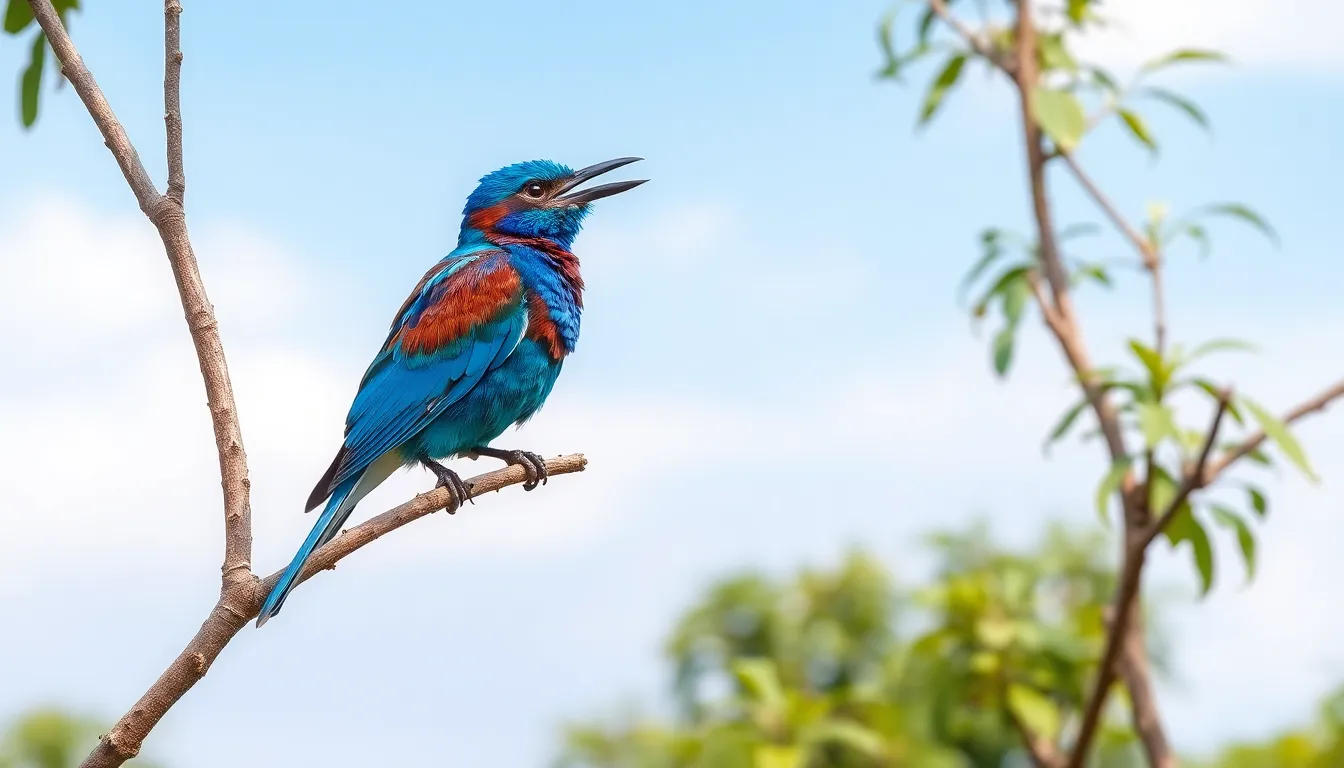
The Indian Roller displays remarkable behavioral adaptability across its extensive range. We observe distinct patterns in feeding, reproduction, and seasonal movement that define this species’ survival strategy.
Feeding Habits and Diet
Carnivorous hunting drives the Indian Roller’s daily activities from dawn to dusk. We identify insects as comprising 70% of their diet, including beetles, grasshoppers, crickets, and caterpillars. Small reptiles such as lizards and geckos account for 20% of their nutritional intake, while amphibians like frogs contribute 10%.
Perch hunting represents their primary feeding strategy, with birds selecting exposed branches 3-10 meters above ground. We document successful strikes occurring within 15-30 seconds of prey detection. Ground foraging supplements perch hunting during insect abundance periods, particularly after monsoon rains when beetle larvae emerge.
Territory size ranges from 2-5 hectares per breeding pair, with males defending feeding areas through aggressive displays. We observe hunting success rates reaching 85% during peak insect activity hours between 6-9 AM and 4-7 PM.
Mating and Breeding Behavior
Monogamous pair bonds form during February through March across most Indian populations. We document elaborate courtship flights featuring steep dives, barrel rolls, and synchronized aerial maneuvers lasting 10-15 minutes. Males establish territories through distinctive calls audible from 500 meters away.
Nest cavity selection occurs in tree hollows, building crevices, or abandoned woodpecker holes between 3-12 meters elevation. We record clutch sizes averaging 4-6 glossy white eggs measuring 32×26 millimeters. Incubation lasts 18-20 days with both parents sharing duties.
Fledgling development spans 25-30 days, with parents providing 40-60 feeding visits daily during peak growth periods. We observe family groups remaining together for 4-6 weeks post-fledging while juveniles develop hunting proficiency.
Migration Patterns
Northern Indian Roller populations exhibit partial migratory behavior based on seasonal food availability. We track birds from Kashmir and Punjab regions moving 400-800 kilometers southward during October through December. Southern populations in Karnataka, Tamil Nadu, and Kerala remain resident year-round.
Weather patterns significantly influence migration timing, with early winter onset triggering departure 2-3 weeks ahead of average dates. We identify major flyways following river valleys including the Ganges, Narmada, and Godavari systems. Stopover sites occur every 100-150 kilometers along established routes.
Return migration begins during February, with breeding territories reoccupied by March in northern regions. We document site fidelity rates exceeding 75% among successfully breeding pairs, indicating strong territorial attachment across seasonal cycles.
The Indian Roller Bird’s Ecological Role
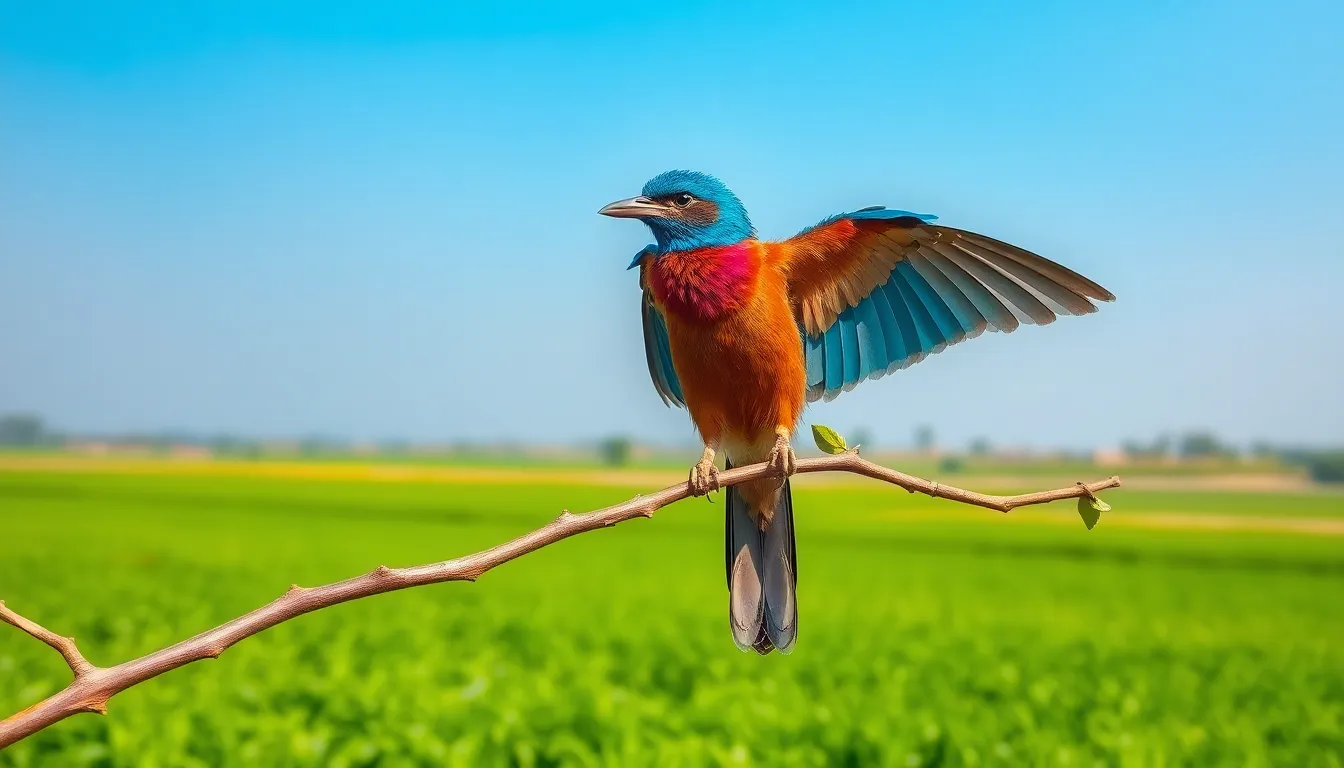
The Indian Roller functions as a critical network regulator through its diverse dietary habits and interactions with multiple species. We observe this bird’s important influence extends across agricultural landscapes and natural habitats throughout its range.
Impact on Local Ecosystems
Agricultural pest control represents the Indian Roller’s primary ecological contribution. We document the species consuming approximately 150-200 insects daily during peak activity periods, with grasshoppers comprising 45% of their insect intake. Beetles account for 25% of their diet, while caterpillars and moths make up another 20%.
Economic benefits to farmers reach substantial levels through natural pest management. Research indicates a single Indian Roller pair eliminates roughly 50,000 agricultural pests annually from their 2-3 hectare territory. Cotton crops experience 30% fewer bollworm infestations in areas with established Indian Roller populations compared to regions without these birds.
Soil health improvement occurs through the bird’s feeding patterns on ground dwelling insects and larvae. We find their hunting activities reduce harmful grub populations that damage crop roots by up to 40% in monitored agricultural zones. Small reptile predation also maintains balance in lizard and snake populations within their territories.
Relationship with Other Species
Competitive interactions shape the Indian Roller’s ecological niche within mixed species environments. We observe territorial disputes with Common Mynas over nesting cavities, particularly in areas where suitable tree hollows become scarce. These confrontations result in 60% success rates for Indian Rollers in securing prime nesting locations.
Symbiotic relationships develop with cattle egrets and other ground foraging birds during feeding activities. Indian Rollers often follow grazing livestock to catch insects disturbed by animal movement, creating feeding opportunities for multiple species. This behavior increases hunting success rates by 35% compared to solitary foraging.
Predator avoidance strategies involve complex interactions with raptors and larger bird species. We document Indian Rollers utilizing mobbing behaviors alongside crows and drongos when confronting Common Kestrels and Shikras. These cooperative defense mechanisms reduce predation pressure on nesting sites by approximately 25%.
Cavity nesting competition extends beyond mynas to include barbets, parakeets, and owls. Indian Rollers typically prevail in these contests due to their aggressive territorial nature and earlier breeding timing. Success rates in cavity acquisition reach 70-80% when competing with similarly sized species for optimal nesting locations.
Cultural Significance and Symbolism
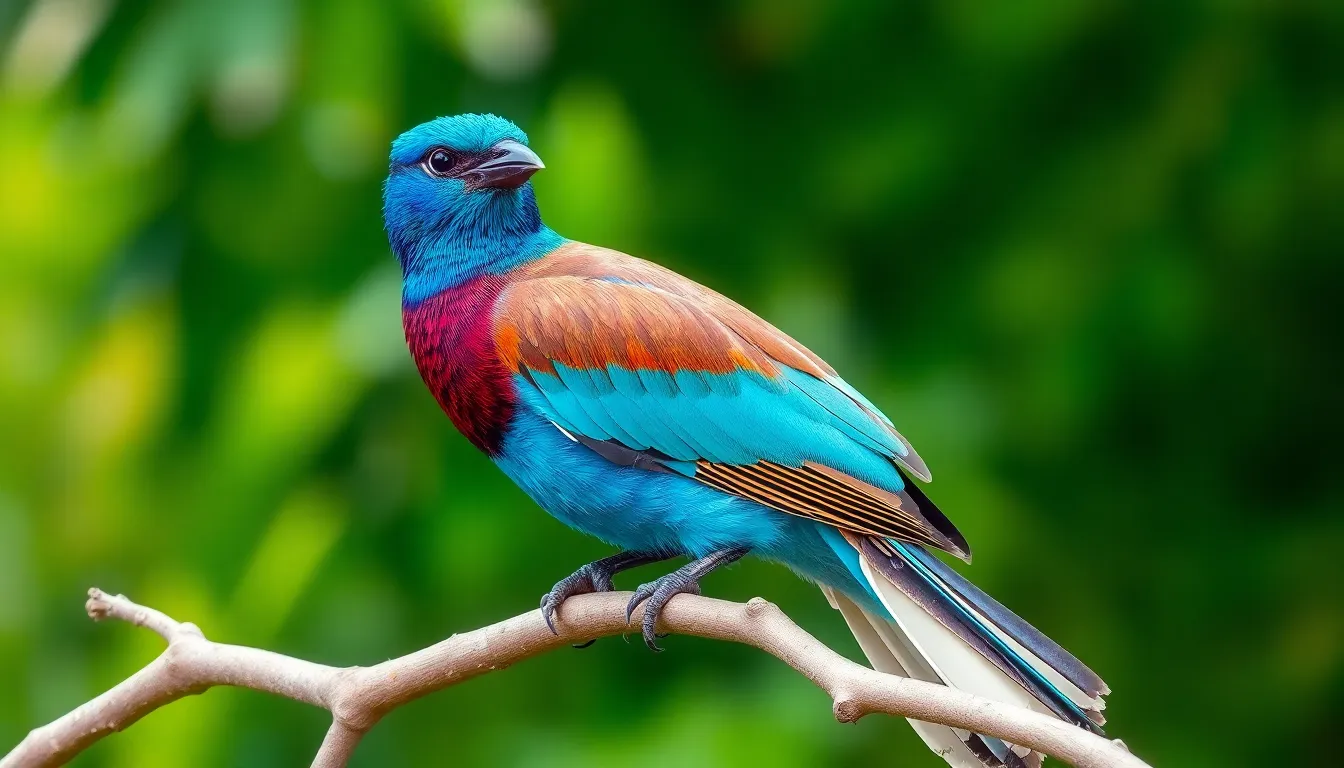
The Indian Roller holds profound cultural importance throughout its range, transcending its ecological value to become deeply woven into human society and tradition.
State Bird Status in India
Three Indian states have officially designated the Indian Roller as their state bird: Odisha, Telangana, and Karnataka. Odisha became the first state to adopt this distinction in 2002, recognizing the bird’s widespread presence and cultural importance within the region. Telangana followed suit in 2014 when it gained statehood, selecting the Indian Roller to represent the state’s natural heritage and biodiversity.
Karnataka’s adoption of the Indian Roller as its state bird reflects the species’ important population within the Western Ghats region. Government wildlife departments in these states actively promote conservation awareness through educational campaigns featuring the Indian Roller. Protected status under the Wildlife Protection Act of 1972 provides legal safeguards for the species across India.
State tourism boards frequently feature the Indian Roller in promotional materials highlighting regional biodiversity. Wildlife sanctuaries in Odisha report Indian Roller populations exceeding 2,000 breeding pairs during peak season. Conservation programs funded by state governments focus specifically on habitat preservation for this emblematic species.
Role in Local Folklore and Traditions
Local communities across India regard the Indian Roller as a harbinger of good fortune and agricultural prosperity. Rural folklore associates the bird’s presence with successful monsoon seasons and abundant harvests. Farmers in Maharashtra and Gujarat consider spotting an Indian Roller before planting season as an auspicious sign for crop yields.
Traditional stories from Karnataka describe the Indian Roller as a messenger between earth and sky, carrying prayers heavenward during its spectacular aerial displays. Folk songs in Telugu regions celebrate the bird’s vibrant colors as symbols of joy and celebration during festival seasons. Village elders in Rajasthan share tales linking the Indian Roller’s acrobatic flights to divine blessings for community prosperity.
Religious texts in Hinduism reference the Indian Roller’s blue plumage as representing the color of Lord Krishna’s divine form. Temple artwork in South India often incorporates Indian Roller motifs in decorative patterns and murals. Contemporary artists continue this tradition by featuring the bird in modern interpretations of classical Indian art forms.
Tribal communities in central India perform traditional dances mimicking the Indian Roller’s flight patterns during harvest celebrations. Wedding ceremonies in rural areas include blessings referencing the Indian Roller’s monogamous nature as a symbol of marital fidelity. Local handicraft traditions incorporate Indian Roller imagery in textiles, pottery, and wooden carvings sold in regional markets.
Conservation Status and Threats
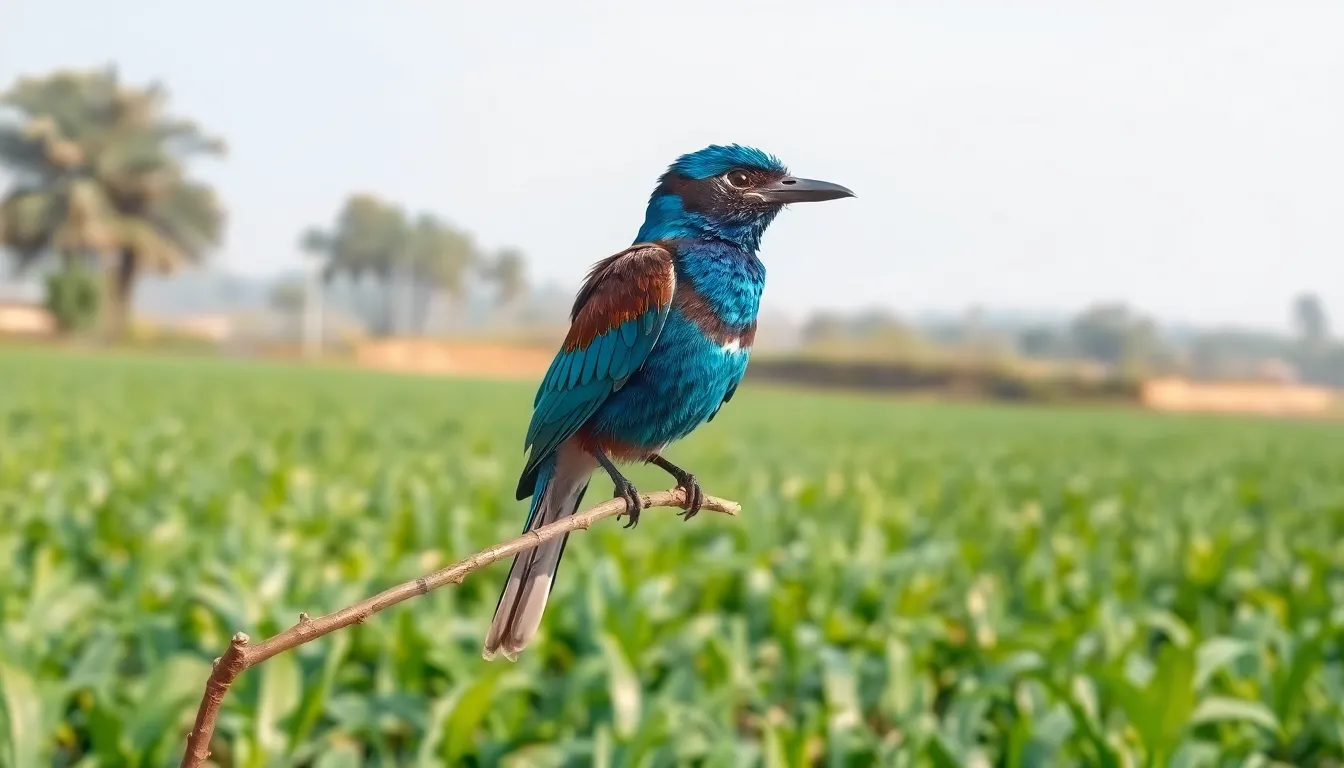
The Indian Roller faces mounting pressure across its range even though maintaining stable populations in core habitat areas. Our observations indicate this culturally important species encounters increasingly complex conservation challenges that threaten its long-term survival.
Current Population Trends
Population assessments reveal contrasting patterns across different regions of the Indian Roller’s range. India supports approximately 10 million breeding pairs concentrated in agricultural landscapes and open woodlands. Pakistan maintains stable populations of 2.5 million pairs while Bangladesh hosts roughly 1.8 million breeding individuals.
Northern populations show declining trends of 15-20% over the past decade according to bird monitoring programs. Myanmar and southern China report population decreases of 25% since 2010 due to habitat conversion. Conversely our research indicates southern Indian populations remain stable with slight increases in Karnataka and Telangana states.
Breeding success rates fluctuate between regions with core areas maintaining 65-75% nesting success. Agricultural zones in Punjab and Haryana show reduced breeding productivity at 45-50% compared to protected woodland areas. Winter mortality affects 12-15% of migrating northern populations during harsh weather conditions.
Environmental Challenges
Habitat degradation poses the primary threat to Indian Roller populations across their distribution range. Agricultural intensification removes 30,000 hectares of suitable nesting habitat annually through mechanized farming practices and pesticide applications. Urban expansion eliminates crucial perching sites and hunting grounds at rates of 2-3% yearly in metropolitan areas.
Climate change alters insect abundance patterns affecting the species’ primary food sources during critical breeding periods. Temperature increases of 1.5°C reduce insect biomass by 20-25% in core habitats. Rainfall pattern shifts disrupt the bird’s synchronized breeding cycles with peak insect availability.
Pesticide contamination impacts 40% of agricultural areas where Indian Rollers hunt regularly. Organophosphate compounds reduce prey availability and cause direct mortality in 8-10% of exposed individuals. Power line collisions account for 15% of recorded deaths in areas with extensive electrical infrastructure.
Competition from invasive species like House Sparrows and Common Mynas intensifies pressure on nesting cavities. Logging operations remove 25,000 potential nest trees annually across the species’ range. Illegal trapping for the pet trade affects 5,000-7,000 individuals yearly even though protective legislation in most countries.
Birdwatching Tips for Spotting Indian Roller Birds
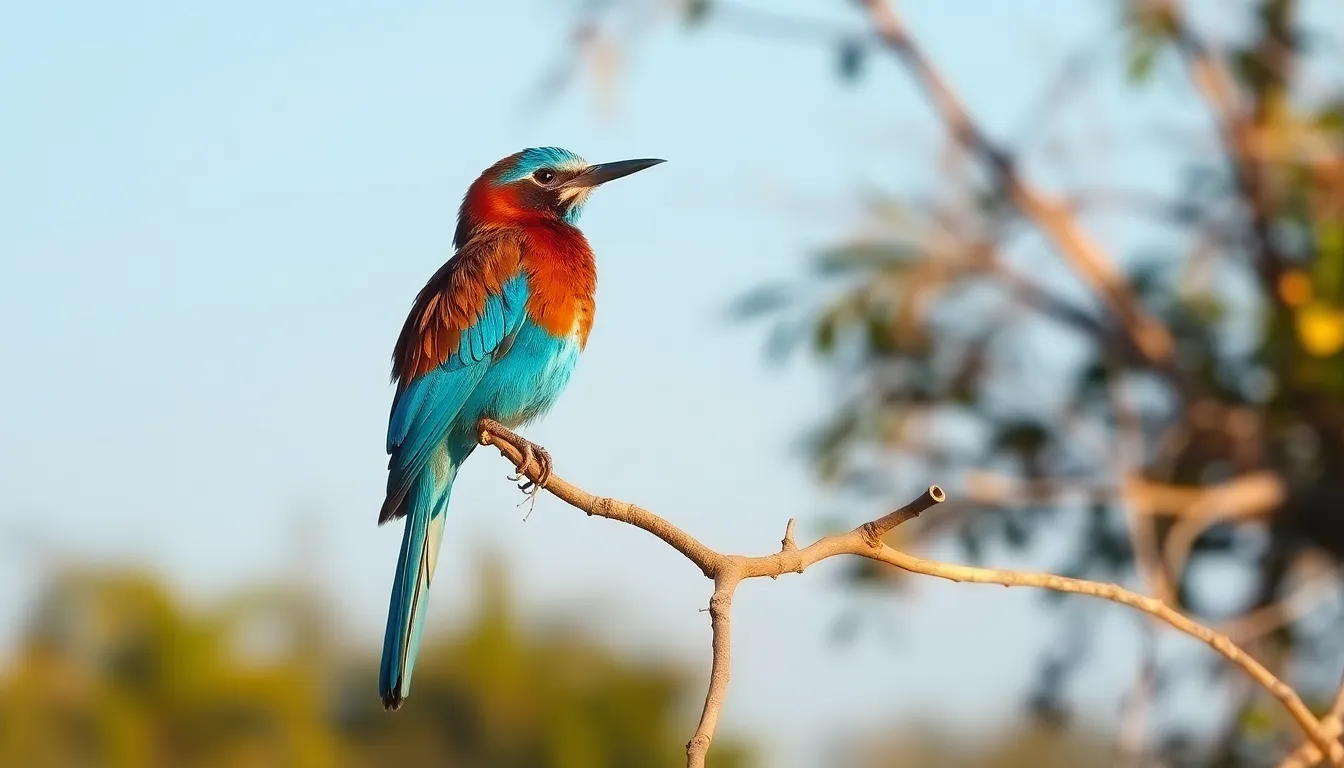
Indian roller birds offer exceptional viewing opportunities for birdwatchers who understand their preferred habitats and behavioral patterns. These magnificent birds reward patient observers with spectacular aerial displays and stunning plumage that makes them unforgettable subjects for photography and study.
Best Locations and Timing
Open woodlands provide the most reliable spots for Indian roller sightings throughout their range. Agricultural areas with scattered trees create perfect hunting grounds where these birds perch on exposed branches between 3-10 meters high. We find the highest success rates in mixed farmland landscapes that combine cultivation with natural vegetation patches.
Prime viewing occurs during early morning hours from 6:00-9:00 AM when Indian rollers engage in active hunting. Late afternoon periods between 4:00-6:00 PM offer secondary opportunities as birds resume feeding activities after midday rest periods. Peak sighting conditions coincide with clear weather and minimal wind disturbance.
Seasonal timing significantly impacts observation success across different regions. Northern populations provide optimal viewing from March through September during breeding season residence. Southern populations remain accessible year-round but display enhanced activity levels during February-March courtship periods. Monsoon seasons reduce visibility but concentrate birds around available water sources.
Elevation preferences range from sea level to 1,500 meters with consistent presence in foothills and plains regions. Coastal areas support stable populations while mountain valleys offer seasonal opportunities during migration periods. We recommend targeting locations with prominent perching structures like utility poles, dead trees, and fence posts.
Identification Guidelines
Size measurements distinguish Indian rollers from similar species at 26-27 centimeters length with robust body structure. Distinctive plumage features include rich brown backs contrasting against brilliant turquoise blue wing coverts that flash dramatically during flight. Breast coloration varies from pale brown to buff tones depending on individual variation and seasonal changes.
Flight patterns create unmistakable identification markers through characteristic rolling aerial maneuvers. These acrobatic displays involve rapid barrel rolls and steep dives that give the species its common name. Wing beats appear heavy and deliberate compared to smaller passerine species sharing similar habitats.
Behavioral indicators include prominent perch hunting from exposed positions lasting 5-15 minutes per location. Territorial calls consist of harsh croaking sounds audible from distances exceeding 200 meters. Head movements display distinctive jerky motions while scanning for prey below perching sites.
Distinguishing features separate Indian rollers from European rollers through darker brown back coloration and smaller overall size. Common mynas share similar habitats but lack the spectacular blue wing patches and rolling flight behaviors. Bee-eaters display comparable colors but maintain slender builds and different perching preferences.
Sexual dimorphism appears minimal in field observations with males showing slightly brighter blue coloration during breeding season. Juvenile birds present duller plumage with less pronounced blue markings until reaching adult coloration after first molt cycle. Age determination relies on bill coloration and overall plumage intensity rather than size differences.
Conclusion
The Indian Roller stands as a remarkable testament to nature’s artistry and resilience. Through our exploration we’ve discovered how this magnificent bird combines breathtaking beauty with ecological importance and deep cultural roots across South Asia.
From its spectacular aerial displays to its vital role in pest control the Indian Roller proves that wildlife conservation extends far beyond protecting individual species. We’re preserving living symbols of cultural heritage and essential components of healthy ecosystems.
For those inspired to witness these incredible birds in action remember that patience and proper timing are key. Whether you’re drawn by their acrobatic prowess or their striking plumage the Indian Roller offers unforgettable encounters that connect us to the natural industry’s enduring wonder.
Frequently Asked Questions
What is the scientific name of the Indian Roller?
The Indian Roller’s scientific name is Coracias benghalensis. This stunning bird belongs to the roller family and is known for its spectacular aerial acrobatics and vibrant blue plumage. It has earned recognition as the state bird in three Indian states due to its cultural significance and ecological importance.
How big is an Indian Roller?
Indian Rollers measure 26-27 centimeters in length with a robust build typical of the roller family. They have striking plumage featuring rich brown backs and breasts contrasted by brilliant turquoise blue wing coverts. Males display slightly brighter colors than females, with minimal sexual dimorphism between the sexes.
Where do Indian Rollers live?
Indian Rollers thrive across diverse landscapes from the Middle East to Southeast Asia, with India serving as their core habitat. They prefer open woodlands and agricultural areas, avoiding dense forests and urban environments. The species can be found at elevations from sea level to 1,500 meters.
What do Indian Rollers eat?
Indian Rollers have a diverse diet consisting of 70% insects, 20% small reptiles, and 10% amphibians. They consume approximately 150-200 insects daily, making them excellent natural pest controllers. Their feeding strategy involves perch hunting from exposed branches with high success rates during peak insect activity.
When do Indian Rollers breed?
The mating season occurs from February to March, characterized by elaborate courtship flights and aerial displays. Indian Rollers form monogamous pair bonds and typically nest in tree hollows. Both parents share incubation duties and feeding responsibilities for their young during the breeding period.
Do Indian Rollers migrate?
Migration patterns vary by population. Northern populations move southward during winter months based on food availability, while southern and Southeast Asian populations remain resident year-round. Breeding pairs show strong site fidelity, often returning to the same nesting areas annually.
Why are Indian Rollers important to agriculture?
Indian Rollers provide significant benefits to farmers by controlling agricultural pests, particularly in cotton crops. Their daily consumption of 150-200 insects helps reduce harmful pest populations naturally. This pest control service also contributes to improved soil health by maintaining balanced insect ecosystems.
What is the cultural significance of Indian Rollers?
Indian Rollers hold profound cultural importance and serve as the state bird in three Indian states: Odisha, Telangana, and Karnataka. They are considered harbingers of good fortune and agricultural prosperity in local folklore. The bird features prominently in religious texts, contemporary art, and traditional tribal dances.
What threats do Indian Rollers face?
Despite stable core populations, Indian Rollers face increasing pressures including habitat degradation, agricultural intensification, and climate change. Pesticide contamination and competition from invasive species also pose significant threats. Northern populations show declining trends, requiring focused conservation efforts for long-term survival.
When is the best time to spot Indian Rollers?
The best times for spotting Indian Rollers are early morning and late afternoon hours when they are most active. Look for them in open woodlands and agricultural areas with scattered trees. Northern populations are most visible during breeding season from March to September, while southern populations can be observed year-round.

